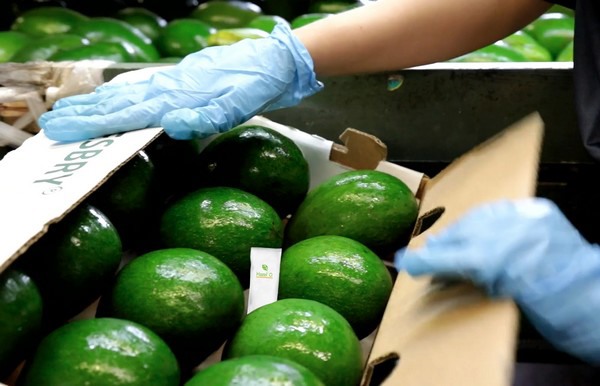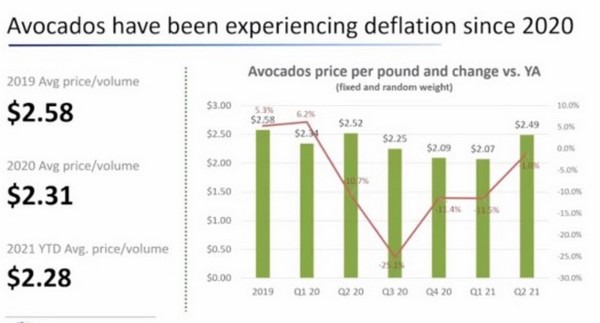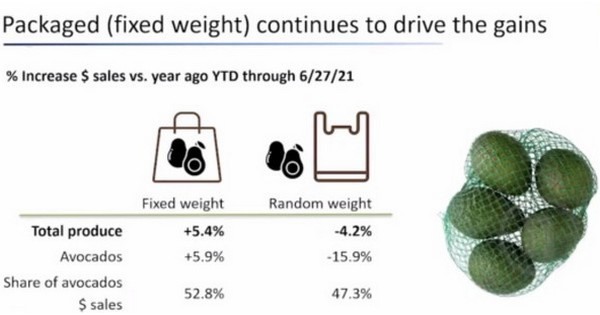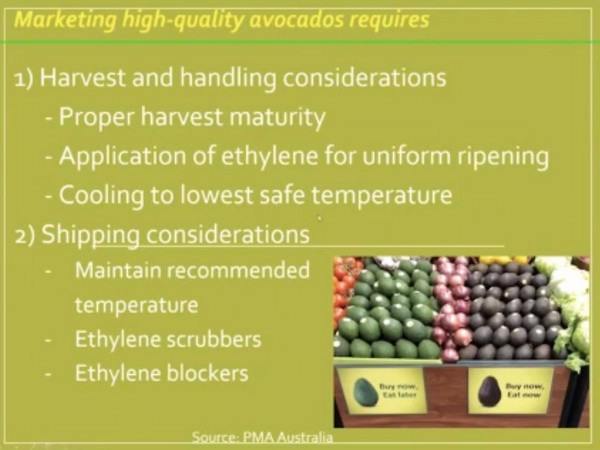Managing the supply chain to optimize use. The development of the category. Minimizing waste. These are just topics touched on in this past Friday’s virtual Avocado Quality Summit hosted by Chicago, IL-based Hazel Technologies.

Sales trends
Anne-Marie Roerink of 210 Analytics began the session covering avocado sales trends. She notes that overall fresh fruit sales for the first six months of 2021 have been ahead of 2020 levels and 16 percent ahead of 2019 levels.
And, volume sales of avocados are up. “We sold one percent more lbs. of avocados in the first half of this year than we in the first half of 2020. But because of a price decline, we are down in dollar growth,” said Roerink. In 2019, the average price per volume was $2.58. In 2020, that dropped to $2.31 and this year, for the first six months, it was an average of $2.28. “Prices are coming back up a little bit but we’re still dealing with lower prices today than in the last couple of years.”
Within the avocado category, the fruit is at about 60 percent household penetration. “It was down a little bit. Trips were flat. People bought avocados equally as often in the first six months of 2021 as they did in 2020. And they spent about two percent less. This is what’s driving that loss in the category,” Roerink notes. However the actual volume sold is stable at more than 500 lbs. per store per week. “That might be a great guideline to push and see what other consumption occasions there are to drive a constant line and additional peaks,” says Roerink.
 Photo: 210 Analytics
Photo: 210 Analytics
New varieties getting noticed
Roerink notes that while the Hass avocado accounts for the majority of the market, new varieties such as the Cocktail and Pinkerton avocados are coming into the category. “It’s very very small sales but they are driving growth and that’s something to explore to get new consumption occasions going,” says Roerink. Other consumer trends include continued strength in fixed weight sales and increasing interest in organics.
Other opportunities are available to continue growing the category. “People love getting tips from their produce department and avocados are one of the most used areas to teach people about ripeness, how to ripen it at home, etc.,” says Roerink.
The other area would be expanding notions around occasions for avocado use. “We all snack so much more than we did before so avocados within the snack occasion can still be a big growth driver,” Roerink says. “And lunch is the most changed meal occasion during the pandemic. People don’t have the amount of time to spend on dinner. There’s a lot of focus on quick sandwiches and salads and that’s where avocados can shine.”
Avocado ripeness is a significant area of focus within the category. “Avocados have a unique ripening pattern--they don’t ripen on the tree as other fruits do. They become sensitive to ethylene once they’re off the tree and the fruit can vary a lot in where in their maturity they are,” says Dr. Steven Sargent, professor and associate chair of Horticultural Studies at the University of Florida.
 Photo: 210 Analytics
Photo: 210 Analytics
Handling at harvest maturity
Sargent notes that marketing high quality avocados requires harvesting and handling at proper maturity. “So applying ethylene for uniform ripening and then cooling it quickly after that to the lowest safe temperature. During shipping, the recommended temperature should be maintained and ethylene scrubbers or blockers can be used during transit,” he adds.
Ripening is obviously a critical area of focus for retailers as well. “At retail, there’s always been a fear of over displaying the product because of the ripeness factor,” said Dick McKellogg, founder of MCK Produce Consulting Inc. and former director of produce & floral merchandising at Lowe’s Foods, on the summit’s panel discussion. “The biggest fear is over allocating space for avocados because once they turn ripe, you could be in a predicament as far as shrink losses go.”
McKellogg noted in his experience at retail, efforts were made to expand allocations and a pre-ripened program was used so fruit was available for customer use. “That worked well. That’s something you have to work back to logistics and how you buy--who will do the preripening for you. But it’s a win win,” he says.
Also part of the panel was Desiree Morales, whose company, WP Produce and CEO of Tropical Fruit Box, markets the greener tropical avocados. “They have a shorter shelf life than Hass but once you cut it, they oxidize at a slower rate. People are becoming aware of them and preferring them because they last longer,” says Morales.
 Photo: Dr. Steven Sargent
Photo: Dr. Steven Sargent
Avocados and foodservice
Ripening and proper handling also plays into providing avocados within foodservice. Thomas McQuillan, vice-president of sales at Baldor Specialty Foods, Inc. notes that the newest generation of chefs are increasingly focused on plant-based cooking. “Finding produce at the center of the plate is much more common than it’s been in a long time. We have a ways to go. But this way you’ll find more room for avocados because they really dress up a dish in a unique way,” says McQuillan.
Chefs are also interested in minimizing waste. “Avocados lets us put a lot of the product to use. If it’s overripe, there are things you can do with it,” says McQuillan. “But we need to have strategies to use 100 percent of the food grown in our country. Could the pit be dehydrated, pulverized and used as a powder in some other recipe for example? We need to get curious and find ways to put all this to use.”
Managing waste also comes from a properly managed supply chain. “I’d like to see more variability in specifications,” says McQuillan. “That’s related to size and blemishes that exist in some of the skin. You can’t judge the quality, taste and ripeness by looking at the fruit. You have to cut into it to see it. So depend on the expert agers to get us fruit in its perfect state and we’ve gotten better at that over the years.”
 For more information:
For more information:
Jaime Kedrowski
Hazel Technologies
Tel: +1 (559) 321-2146
jaime@hazeltechnologiesinc.com
www.hazeltechnologies.com
